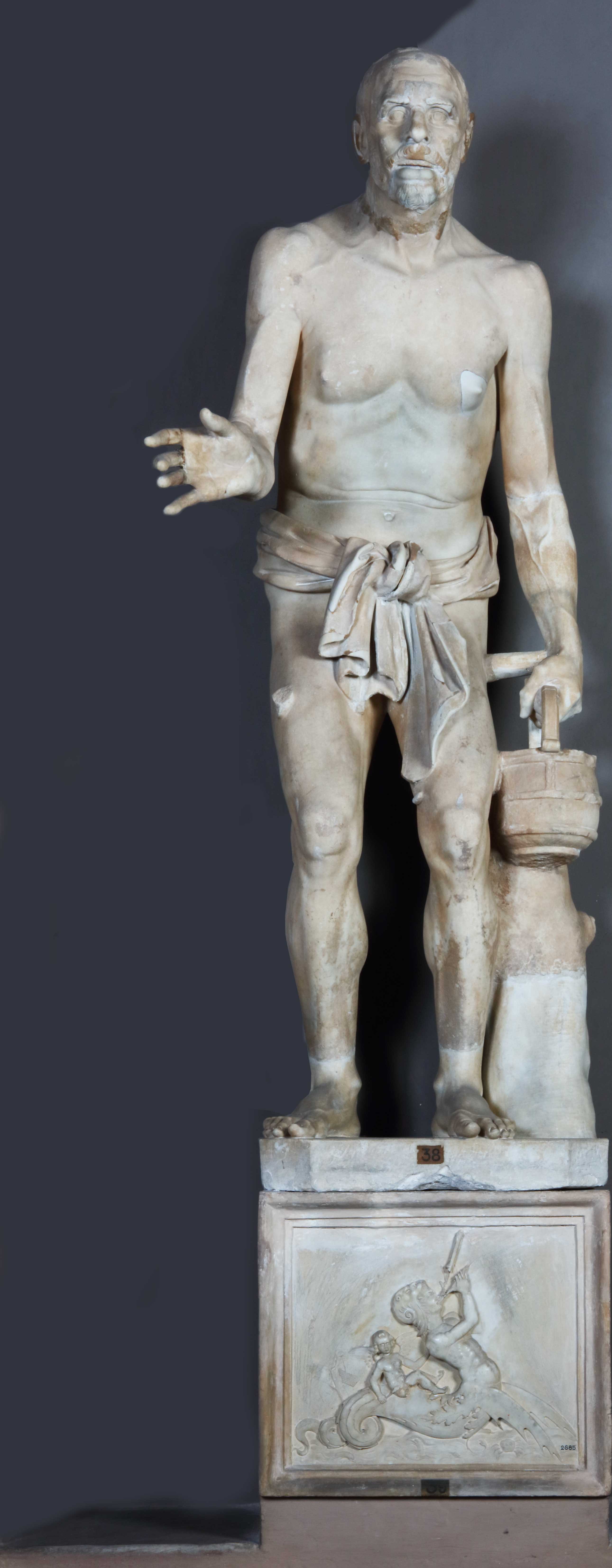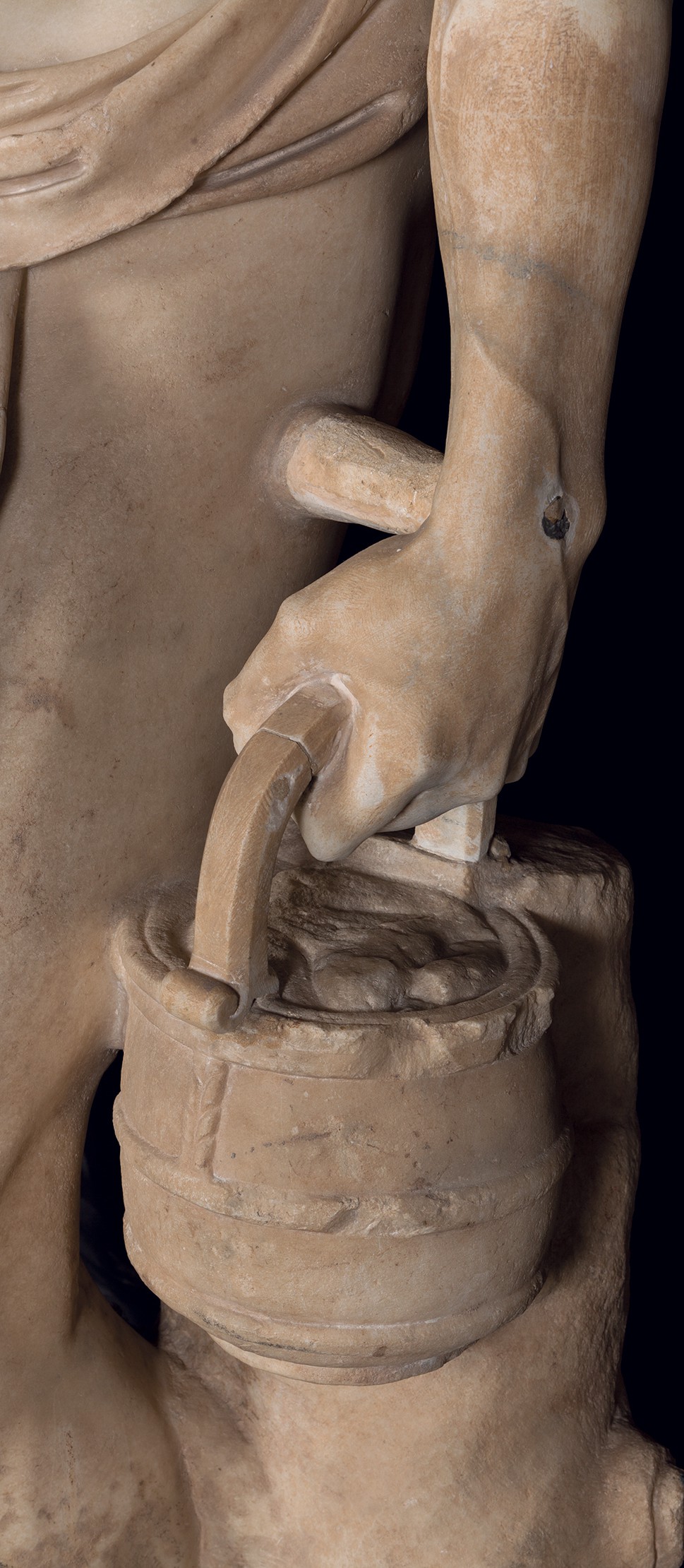Statue of an Old Fisherman
Artist: Unknown
Date: 130 - 140 A.D.
Classification: Sculpture
Dimensions: Height 160.5 cm
Materials: White marble with visible crystals and grey veining
Adopted By: The Minnesota & North Dakota Chapter
Total Cost: € 16,100
Description
The statue, standing at 160.5 cm in height, comes from the Pamphilj excavations at Anzio during the eighteenth century. The statue was long preserved at Villa Doria Pamphili where it was restored by Alessandro Algardi. In 1773, Prince Doria gifted the statue to Pope Clement XIV.
The elderly figure stands slightly curved forward and is dressed in a single cloth (subligaculum) girded at the waist and knotted under the navel. The right arm is positioned at the side of the torso and extends in front of the body, perhaps leaning against a stick that has since disappeared from the sculpture. The left arm is stretched along the side of the body holding a small basket of fish.
Before Winckelmann’s analysis of the sculpture, the nude statue of the elder, covered only by a cloth around the hips, had been interpreted as a portrait of the philosopher Seneca during his act of suicide. Winckelmann disagreed with this interpretation and he assessed the figure in its nakedness as a servant, possibly a representation for the Comedia. The correct identification of the subject as an elderly fisherman finally came when archeologist Ennio Quirino Visconti observed that the basket in his left hand contained fish.
This kind of iconography is called “Vatican-Louvre,” a style of sculpture which derives from principal examples of Ancient replicas and is steeped in the life-like appearance of the figure, as was characteristic of the middle Hellenistic Age. It can be traced back to an Alexandrian original – perhaps in bronze – from the middle of the third century B.C. This statue, derived from this model, is an excellent quality replica dating back to 130-140 A.D.
State of Preservation
The sculpture shows the presence of blackish patina-like coating that now needs to be removed. Various modern integrations are also present. The imminent conservation efforts will indeed allow visitors to more fully enjoy the grandeur of the piece.
Restoration Procedures
- Scientific analysis and study of the interior structure of the statue
- Overall cleaning
- Removal of old restorations
- Replacement of iron nails with stainless-steel and carbon fiber elements where needed
- Photographic documentation
Detail
Adopted By:
The Minnesota & North Dakota ChapterInventory N°: 2684
Artist: Unknown
Date: 130 - 140 A.D.
Dimensions: Height 160.5 cm
Materials: White marble with visible crystals and grey veining
Department:
Greek and Roman AntiquitiesCurators:
Dr. Giandomenico SpinolaLaboratories:
Stone MaterialsWishbook year: 2019
Total Cost
€ 16,100

Statue of an Old Fisherman

Details
Adopted by: The Minnesota & North Dakota Chapter
Inventory: 2684
Artist: Unknown
Date: 130 - 140 A.D.
Classification: Sculpture
Materials: White marble with visible crystals and grey veining
Dimensions: Height 160.5 cm
Department: Greek and Roman Antiquities
Laboratory: Stone Materials
Wishbook year: 2019
Description
The statue, standing at 160.5 cm in height, comes from the Pamphilj excavations at Anzio during the eighteenth century. The statue was long preserved at Villa Doria Pamphili where it was restored by Alessandro Algardi. In 1773, Prince Doria gifted the statue to Pope Clement XIV.
The elderly figure stands slightly curved forward and is dressed in a single cloth (subligaculum) girded at the waist and knotted under the navel. The right arm is positioned at the side of the torso and extends in front of the body, perhaps leaning against a stick that has since disappeared from the sculpture. The left arm is stretched along the side of the body holding a small basket of fish.
Before Winckelmann’s analysis of the sculpture, the nude statue of the elder, covered only by a cloth around the hips, had been interpreted as a portrait of the philosopher Seneca during his act of suicide. Winckelmann disagreed with this interpretation and he assessed the figure in its nakedness as a servant, possibly a representation for the Comedia. The correct identification of the subject as an elderly fisherman finally came when archeologist Ennio Quirino Visconti observed that the basket in his left hand contained fish.
This kind of iconography is called “Vatican-Louvre,” a style of sculpture which derives from principal examples of Ancient replicas and is steeped in the life-like appearance of the figure, as was characteristic of the middle Hellenistic Age. It can be traced back to an Alexandrian original – perhaps in bronze – from the middle of the third century B.C. This statue, derived from this model, is an excellent quality replica dating back to 130-140 A.D.
State of Preservation
The sculpture shows the presence of blackish patina-like coating that now needs to be removed. Various modern integrations are also present. The imminent conservation efforts will indeed allow visitors to more fully enjoy the grandeur of the piece.
Restoration Procedures
- Scientific analysis and study of the interior structure of the statue
- Overall cleaning
- Removal of old restorations
- Replacement of iron nails with stainless-steel and carbon fiber elements where needed
- Photographic documentation
Media

Pescatore

Statue of an Old Fisherman - Before Restoration

© 2025 Patrons of the Arts
in the Vatican Museums
Vatican Museums V-00120,
Vatican City State (Europe)
+39 0669864499
